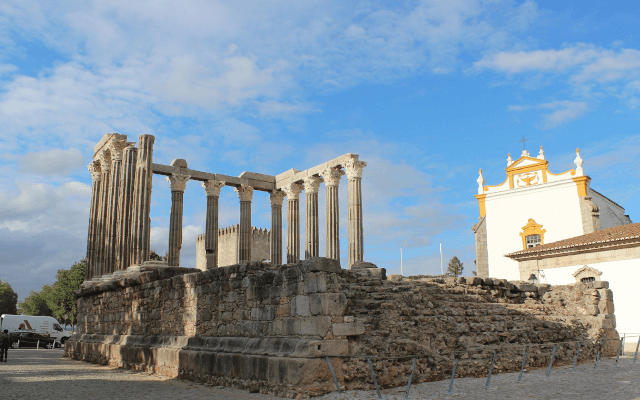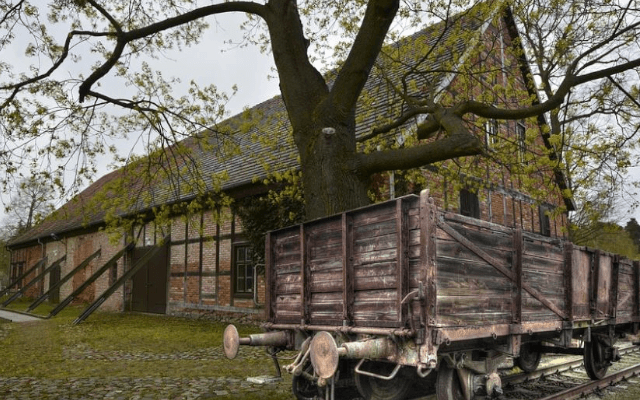
Evora in Portugal is a tourist favourite. Around an hour and a half away from the capital, visitors often come here on a day trip from Lisbon to see the sights offered by this beautifully preserved medieval town, then disappear just as quickly. Despite this, there are more than enough things to do in Evora to keep you busy for several days. So why not take a longer break in Evora – it won’t disappoint.
1. Explore Évora’s Roman Temple
Portugal’s greatest Roman monument which is situated at the highest point of the Evora where the city’s ancient forum once stood. This amazing Corinthian temple was built in the 1st century and would likely have been devoted to Diana. Up close you’ll see the distinction in materials: the fluted columns are produced using rock while the bases and capitals are marble that was brought here from Estremoz, 40 or so kilometers toward the upper east. This landmark has endured so well as it was incorporated into the local castle, before being reestablished during the 1870s.
2. Pray at Évora Cathedral Church
This structure was finished in stages from the earliest starting point of the thirteenth century, so it has a confuse of design, with an enormous Gothic nave, Manueline ensemble with humble vaulting and Baroque churches. The landmark has been totally opened up to guests, so you go out onto the housetop patio to look down on Évora or enter the Gothic groups, which have orange trees in their nursery. There’s additionally a little historical center for the treasury with a flickering arrangement of ritualistic gold and silverwork. Additionally at the highest point of the town is Évora’s directing pink stone church, indisputable for its solid towers with conical spires.

3. Pop into the Carriage Museum
Stroll around the back of the church building and you’ll see one of Evora’s hidden gems. Some portion of the Eugénio de Almeida Foundation, this little historical center shows the family’s fine assortment of carriages and related things. Watch the short video for setting and knowledge into the lives of this prominent family. Located at Páteo de S. Miguel, Largo Dr. Mário Chicó opens Tuesday to Sunday from 10:00 am to 12:30 pm and from 13:30 pm to 18:00 pm and the ticket is worth €1.
4. Explore Évora University
Portugal’s second-oldest university is in Évora and was founded in the 1500s by both Pope Paul IV and the future King Henry I, who was a cardinal at the time. For its first 200 years, it was a Jesuit college, before this order was expelled from Portugal in the 1750s. There’s a great deal to
overcome here, however you need to overview the exquisite arcades and exhibitions in the main courtyard. And don’t miss the chance to see some of the classrooms, as these are decorated with azulejos that vary according to the fields taught. You might notice Aristotle teaching Alexander the Great or Plato instructing his followers.
5. Learn the History of Evora at the Historic Centre
Évora’s World Heritage Site contains the entirety of the old town within the city walls, sloping up to the Cathedral and Roman Temple. If your idea of the perfect afternoon is aimless exploration and finding perfect photo opportunities at random, old Évora will be up your street. The houses on maze-like streets and elongated squares are whitewashed, with wrought-iron balconies and cute azulejos. Most are from the 1400-1700 and take you back to when Évora was favored by royalty. Around this time Portugal was extending its influence to the New World, and this city had a strong influence on Brazilian architecture, here you can get to know what is California known for.
6. The Beauty of Evora’s Noble Houses
Alongside Portuguese rulers, the court moved to Évora during the 1400s and 1500s, enriching the city with bunches of recognized houses to spot as you potter around. See the Paço dos Duques de Cadaval, which has towers that are a piece of the city dividers and insides that you can enter, improved with period furniture and works of art. The Paço dos Condes de Basto is
attached to the Roman walls and stands out for its loggia and Moorish-style horseshoe window arches. Casa Garcia de Resende is identified by its Manueline (early-16th-century) stonework above its main window, while Casa Source has an arcaded gallery crested by a white conical spire.
7. Roam around Praça do Giraldo
Évora’s main square was laid out in the 16th century, and at this time it was the scene of the Spanish Inquisition court, which handed out thousands of brutal sentences here. On a lighter note, it also boasts the marble Fonte Henrique, at the same location as an earlier, 16th-century fountain built to commemorate the Agua Prata aqueduct. There are eight spouts in the
fountain, each for one of the streets branching off the square. The north side is taken up by the striking veneer of the Church of Santo Antão, while all down the east side there’s a persistent arcade, concealing bistros and claim to fame shops.
8. Visit Silver Water Roman Aqueduct
Outside of Évora’s defensive walls, you will locate the renowned Silver Water Roman Aqueduct. Ruler João III appointed the task and development were finished in 1537. It was utilized to supply Évora with water and was the structure of Francisco de Arruda, who additionally planned the Belém Tower in Lisbon. This water channel is a demonstration of Roman-Roman-inspired construction.
9. Dont Miss The Chapel of Bones
The Bone Chapel is probably the most famous thing to do in Evora in Portugal. This creepy chapel is covered with bones of the monks who used to live in the Franciscan monastery. When you visited it was quiet but in the high season expect it to be much busier with tour groups and other visitors. Above the entrance to the chapel is an inscription These bones that lay here wait to welcome yours a potent reminder of how fragile life is, and how we will all end up the same way. The chapel and temporary exhibition space (currently showcasing a huge collection of nativityscenes) cost 5€ per person, here you can get to know about the best cities in France.
10. Jardim Publico Park & Gardens
This park on the south side of the city is perfect for a gentle stroll orto sit and have an ice cream while watching the ducks, and occasionalpeacock strut past. There are some ‘fake’ ruins here, and a wall forgraffiti and street art. Also inside the park is the 16th-century palaceof King Manuel, although it was undergoing restoration work.
